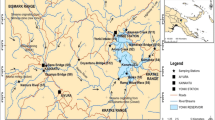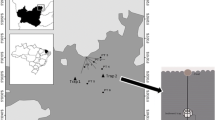Abstract
Emissions of Cu, Zn and Mn and their fate in a typical tilapia (Oreochromis niloticus) cage farm in an artificial reservoir in northeastern Brazil were estimated through the analysis of their concentrations in the various compartments of the farm. Major source of Cu and Zn, but not of Mn, to the farm is from aquafeeds, with annual inputs of 3.83, 57.50 and 10.95 kg.ha−1, respectively. Notwithstanding, only a small fraction of the added Mn and Zn (0.13%, 2.61%, respectively) is incorporated into fish biomass, resulting in a larger proportion of the introduced metals to be exported to reservoir environment. For Cu, a much larger fraction (47.4%) is exported within the fish biomass. Once released, metals are incorporated into bottom sediments within the farm area, resulting in higher metal contents compared to sediments far from the farm area. However, the analysis of sediment cores and the respective enrichment factors showed that a significant fraction of the net input of Zn (70%) and of Cu (30%) is exported out to the open reservoir.





Similar content being viewed by others
References
Barcellos C, Lacerda LD, Ceradini S (1997) Sediment origin and budget in Sepetiba Bay (Brazil) - an approach based on multi-element analysis. Environ Geol 32:203–209
Berntssen MHG, Hylland K, Julshamn K, Lundebye AK, Waagbø R (2004) Maximum limits of organic and inorganic mercury in fish feed. Aquac Nutr 4:83–97
Boyd CE, Massaut L (1999) Risks associated with the use of chemicals in pond aquaculture. Aquac Eng 20:113–132
Dean RJ, Shimmield TM, Black KD (2007) Copper, zinc and cadmium in marine cage fish farm sediments: an extensive survey. Environ Pollut 145:84–95
DNOCS (2015) Departamento Nacional de Obras Contra as Secas – Available at: http://www.dnocs.gov.br/php/comunicacao/noticias.php. Accessed on 5th November 2015
Dorea JG (2006) Fish meal in animal feed and human exposure to persistent bioaccumulative and toxic substances. J Food Prot 11:2777–2785
El-Sadaawy MM, El-Said GF, Sallam NA (2013) Bioavailability of heavy metals in fresh water Tilapia nilotica (Oreachromis niloticus Linnaeus, 1758): Potential risk to fishermen and consumers. J Environ Sci Health B 48:402–409
Farmaki EG, Thomaidis NS, Pasias IN, Baulard C, Papaharisis L, Efstathiou CE (2014) Environmental impact of intensive aquaculture: Investigation on the accumulation of metals and nutrients in marine sediments of Greece. Sci Total Environ 485(486):554–562
Go G, Aktumsek A, Citil OB, Arslan A, Torlak E (2007) Seasonal variations on total fatty acid composition of fillets of zander (Sander lucioperca) in Beysehir Lake (Turkey). Food Chem 103:1241–1246
Gu Y, Yang Y, Lin Q, Li Q, Wang Z, Wang X (2012) Spatial, temporal, and speciation variations of heavy metals in sediments of Nan’ao Island, a representative mariculture base in Guangdong coast, China. J Environ Monit 14:1943–1950
Ikem A, Egilla J (2008) Trace element content of fish feed and bluegill sunfish (Lepomis macrochirus) from aquaculture and wild source in Missouri. Food Chem 110:301–309
Johnston JN, Savage GP (1991) Mercury consumption and toxicity with reference to fish and fishmeal. Nutr Abstr 61:74–116
Kalantzi I, Shimmield TM, Pergantis SA, Papageorgiou N, Black KD, Karakassis I (2013) Heavy metals, trace elements and sediment geochemistry at four Mediterranean fish farms. Sci Total Environ 444:128–137
Kelly BC, Ikonomou MG, Higgs DA, Oakes J, Dubetz C (2008) Mercury and other trace elements in farmed and wild salmon from British Columbia, Canada. Environ Toxicol Chem 27:1361–1370
Kwok CK, Liang Y, Wang H, Dong YH, Leung SY, Wong MH (2014) Bioaccumulation of heavy metals in fish and Ardeid at Pearl River Estuary, China. Ecotoxicol Environ Saf 106:62–67
Lacerda LD, Costa BGB, Naiane D, Oliveira KF, Bezerra MF, Bastos WR (2014) Mercury in indigenous, introduced and farmed fish from the semiarid region of the Jaguaribe River Basin, NE Brazil. Bull Environ Contam Toxicol 93:31–35
Loring DH, Rantala RTT (1992) Manual for the geochemical analyses of marine sediments and suspended particulate matter. Earth-Sci Rev 32:235–283
Low KH, Zain SM, Abas MR, Salleh KM, Teo YY (2015) Distribution and health risk assessment of trace metals in freshwater tilapia from three different aquaculture sites in Jelebu Region (Malaysia). Food Chem 177:390–396
Marengoni NG, Klosowski ES, Oliveira KP, Chambo APS, Gonçalves Junior AC (2013) Bioacumulação de metais pesados e nutrientes no mexilhão dourado do reservatório da Usina Hidrelétrica de Itaipu Binacional. Quim Nov. 36:359–363
Marengoni NG, Wild MB, Gonçalves Junior AC, Vivian MMPS, Moura MC (2014) Bioaccumulation of heavy metals in Nile tilapia and concentrations in soil and sediment of the ponds with addition of the probiotics in the diet. Biosci J 30:1158–1167
Medeiros PHA, Araújo JC, Mamede GL, Creutzfeldt B, Güntner A, Bronstert A (2014) Connectivity of sediment transport in a semiarid environment: a synthesis for the Upper Jaguaribe Basin, Brazil. J Soils Sediments 14:1938–1948
Mendiguchía C, Moreno C, Mánuel-Vez MP, García-Vargas M (2006) Preliminary investigation on the enrichment of heavy metals in marine sediments originated from intensive aquaculture effluents. Aquaculture 254:317–325
Molisani MM, Monte TM, Vasconcellos GH, Barroso HS, Moreira MOP, Becker H, Rezende CE, Farias EGG (2015) Relative effects of nutrient emission from intensive cage aquaculture on the semiarid reservoir water quality. Environ Monit Assess 187:707–715
Mountouris A, Voutsas E, Tassios D (2002) Bioconcentration of heavy metals in aquatic environments: the importance of bioavailability. Mar Pollut Bull 44:1136–1141
Oliveira RCB, Marins RV (2011) Dinâmica de Metais-traço em Solo e Ambiente Sedimentar Estuarino como um Fator Determinante no Aporte desses Contaminantes para o Ambiente Aquático: revisão. Rev Virt Quím 3:88–102
Oliveira KF, Lacerda LD, Peres TF, Bezerra MF, Dias FJS (2015) Emission factor and balance of mercury in fish farms in an artificial reservoir in NE-Brazil. Environ Sci Pollut Res 22:18278–18287
Rožič PZ, Dolenec T, Baždarić B, Karamarko V, Kniewald G, Dolenec M (2012) Major, minor and trace element content derived from aquacultural activity of marine sediments (Central Adriatic, Croatia). Environ Sci Pollut Res 19:2708–2721
Russell M, Robinson CD, Walsham P, Webster L, Moffat CF (2011) Persistent organic pollutants and trace metals in sediments close to Scottish marine fish farms. Aquaculture 319:262–271
Salomons W, Föstner U (1984) Metals in the hydrocycle. Springer Verlag, Berlin
Santos JA, Marins RV, Aguiar JE, Chalar G, Silva FATF, Lacerda LD (2016) Hydrochemistry and trophic state change in a large reservoir in the Brazilian northeast region under intense drought conditions. J Limnol. doi:10.4081/jlimnol.2016.1433
SEBRAE (2008) Serviço Brasileiro de Apoio às Micro e Pequenas Empresas. Manual do Produtor. http://www.emater.go.gov.br/intra/wpcontent/uploads/downloads/2013/08/Manual-Produ%C3%A7%C3%A3o-Til%C3%A1pia-em-tanque-Rede.pdf Assessed in December, 2016
SEBRAE (2015) Serviço Brasileiro de Apoio às Micro e Pequenas Empresas. Aquicultura no Brasil. Available at: http://www.bibliotecas.sebrae.com.br/chronus/ARQUIVOS_CHRONUS/bds/bds.nsf/4b14e85d5844cc99cb32040a4980779f/$File/5403.pdf Assessed in December, 2016
Tacon AGJ, Forster IP (2003) Aquafeeds and the environment: policy implications. Aquaculture 226:181–189
Tajiri AN, Pontes Netto D, Sassahara M, Rodrigues MSM, Arruda CAC (2011) Determination of presence and quantification of cadmium, lead and copper in Nile tilapia (Oreochromis niloticus) fillets obtained from three cold storage plants in the State of Parana, Brazil. Cienc Tecnol Aliment 31:361–365
Thomas M, Lazartigues A, Banas D, Brun-Bellut J, Feidt C (2012) Organochlorine pesticides and polychlorinated biphenyls in sediments and fish from freshwater cultured fish ponds in different agricultural contexts in northeastern France. Ecotoxicol Environ Saf 77:35–44
USEPA (2000) Guidance for Assessing Chemical Contaminant Data for Use in Fish Advisories. Vol. 1: Fish Sampling and Analysis. EPA 823-B-00-007. Office of Science and Technology Office of Water U.S. Environmental Protection Agency Washington, DC, v. 2
Voigt CL, Silva CP, Campos SX (2016) Avaliação da bioacumulação de metais em Cyprinus carpio pela interação com sedimento e água de reservatório. Quim Nov. 39:180–188
Wu XY, Yang FY (2010) Accumulation of heavy metals and total phosphorus in intensive aquatic farm sediments: comparison of tilapia Oreochromis niloticus, Oreochromis aureu, Asian seabass Lates calcarifer and white shrimp Litopenaeus vannamei farms. Aquac Res 41:1377–1386
Acknowledgements
This study was supported by research grants FUNCAP-CAPES (Proc. No. AE1-0052-000120100/11) e CNPq-MPA (404.716/2012-1). It also received a contribution from the CNPq–INCT-TMCOcean, (Proc. No. 573.601/2008-9) research network.
Author information
Authors and Affiliations
Corresponding author
Rights and permissions
About this article
Cite this article
Oliveira, K.F., Lacerda, L.D., Peres, T.F. et al. The Fate of Cu, Zn and Mn in an Intensive Fish Aquaculture (Tilapia - Oreochromis niloticus) in an Artificial Reservoir in Northeastern Brazil. Environ. Process. 4, 107–121 (2017). https://doi.org/10.1007/s40710-016-0206-7
Received:
Accepted:
Published:
Issue Date:
DOI: https://doi.org/10.1007/s40710-016-0206-7




